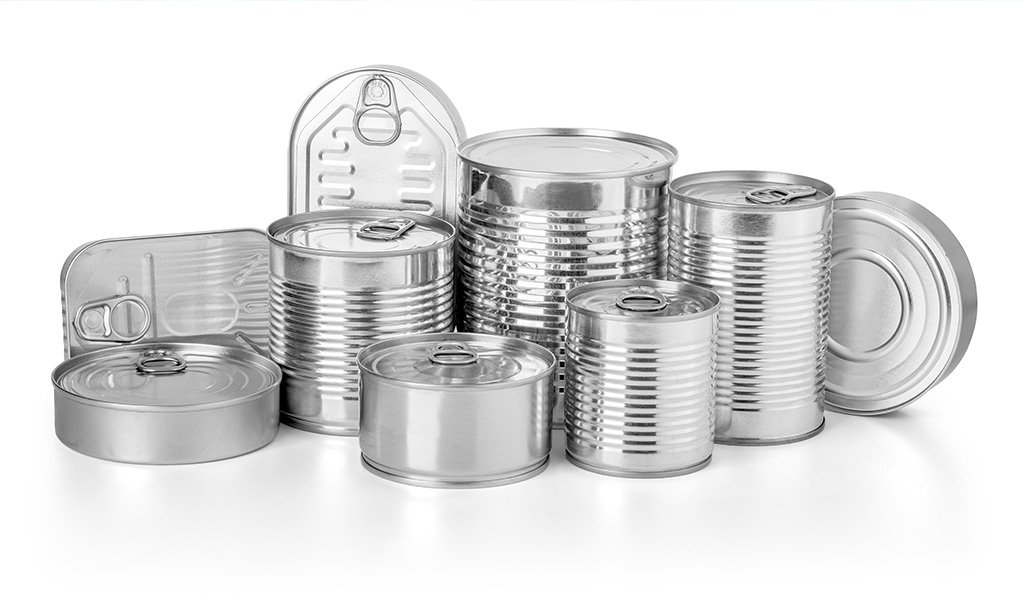despite the name, they're not made primarily of tin and never were
they used to be made of tinplate - a thin sheet of steel with a thin coating of tin
this prevents corrosion
they used to be made of tinplate - a thin sheet of steel with a thin coating of tin
this prevents corrosion
nowadays they're usually made of steel lined inside (and sometimes outside) with a plastic film
this started a lot earlier than I thought - the 1950s
they used epoxy resins made with bisphenol A or "BPA"
this has become a problem
this started a lot earlier than I thought - the 1950s
they used epoxy resins made with bisphenol A or "BPA"
this has become a problem

the problem is BPA is an endocrine disruptor
it can block some hormones and mimic others
it's been linked to heart disease, fertility problems and liver failure
and the body isn't great at eliminating it, so it builds up over time
it can block some hormones and mimic others
it's been linked to heart disease, fertility problems and liver failure
and the body isn't great at eliminating it, so it builds up over time
BPA can leach into food from the plastic lining
this leaching happens faster when the can is hot or when the food contains high levels of fat or acid
this leaching happens faster when the can is hot or when the food contains high levels of fat or acid
the Can Manufacturers Institute says 98 of U.S. cans are now BPA free
manufacturers now use polyester epoxy, acrylic or olefin polymers
manufacturers now use polyester epoxy, acrylic or olefin polymers
back to the can itself
for purposes of the next few tweets, I'm gonna talk about probably the most famous can there is
for purposes of the next few tweets, I'm gonna talk about probably the most famous can there is

this can is what's called a "picnic" or "No. 1" size
obviously there are a bunch of sizes, but we'll get to that in a little while
it has a capacity of 10.94 fluid ounces, but Campbell's fills it to 10.75
it stands 4 inches high and has a diameter of 2 11/16 inches
obviously there are a bunch of sizes, but we'll get to that in a little while
it has a capacity of 10.94 fluid ounces, but Campbell's fills it to 10.75
it stands 4 inches high and has a diameter of 2 11/16 inches
wife is running late and I gotta put a couple kids to bed
please enjoy this brief musical interlude
please enjoy this brief musical interlude
sorry about that
back to the can
including lid and label, it weighs 46 grams or 1.6 ounces
back to the can
including lid and label, it weighs 46 grams or 1.6 ounces
I said this was probably the most famous can there is
in 1962, pop artist Andy Warhol painted a set of 32 canvases
one for each flavor Campbell's made
Warhol said he ate a bowl of Campbell's soup for lunch every day
in 1962, pop artist Andy Warhol painted a set of 32 canvases
one for each flavor Campbell's made
Warhol said he ate a bowl of Campbell's soup for lunch every day

Irving Blum, Warhol's gallerist, sold five of the paintings
Dennis Hopper bought tomato
Blum soon regretted this, and bought them back to keep the set together
Dennis Hopper bought tomato
Blum soon regretted this, and bought them back to keep the set together

in 1996, Blum sold the set to the Museum of Modern Art for $15 million
let's get back to the actual cana
let's get back to the actual can and talk manufacturing
let's get back to the actual can and talk manufacturing
a soup can is what's called a "3-piece can"
a body and two ends
it has three seams - one each at the top and bottom, and a third down the length of the can
a body and two ends
it has three seams - one each at the top and bottom, and a third down the length of the can

actually we won't
I numbered those stupidly
I numbered those stupidly
3. the body
this starts out as a huge coil of steel strip
it's cut into large sheets, big enough for several cans
it's then coated on what will be the inside with epoxy and baked in an oven, then cut into single-can sizes
this starts out as a huge coil of steel strip
it's cut into large sheets, big enough for several cans
it's then coated on what will be the inside with epoxy and baked in an oven, then cut into single-can sizes
a machine rolls it into a cylinder and welds the seam - applies an electric current to the edges, heating the edges enough so they melt together
another coat of epoxy is sprayed along the inside surface of the weld and hot air is blown in to cure it
another coat of epoxy is sprayed along the inside surface of the weld and hot air is blown in to cure it
the cans now move to a flanging machine that bends the top and bottom edges outward, so they can mate with the ends 

6 & 7. the maker's end and seam
this is the bottom of the can
so for purposes of these illustrations, the can is upside down
a lid with a curled edge is placed over the flanged end of the can
this is the bottom of the can
so for purposes of these illustrations, the can is upside down
a lid with a curled edge is placed over the flanged end of the can

a machine pushes on the curve of the lid so that it rolls under the flange of the can body
a second roller than mushes the whole seam together
this was the most surprising part of the process to me - no weld, no solder, no glue or anything
just metal and metal and force
🤘


a second roller than mushes the whole seam together
this was the most surprising part of the process to me - no weld, no solder, no glue or anything
just metal and metal and force
🤘


4. the beading
these are the ridges or corrugation running latitudinally around the body of the can
they strengthen the can to prevent dents or crushing
the empty, one-ended can is run through a machine that applies rollers inside and out to create the beading
these are the ridges or corrugation running latitudinally around the body of the can
they strengthen the can to prevent dents or crushing
the empty, one-ended can is run through a machine that applies rollers inside and out to create the beading
1 and 2. the canner's end and seam
this is the top of the can
the can is filled with its contents - hot
hot enough to sterilize the food and the inside of the can
then the top end is crimped on
this is the top of the can
the can is filled with its contents - hot
hot enough to sterilize the food and the inside of the can
then the top end is crimped on
dangit, i broke the thread
i hate when that happens
continue here
i hate when that happens
continue here
https://x.com/mattbramanti/status/1819205554423701510
after the can is filled and sealed, it goes into a machine that glues the paper label to the can
apocryphal story time
Carnation Milk first appeared in 1899, and at first struggled to find a market
the company put out ads asking customers to write in and suggest a slogan
Carnation Milk first appeared in 1899, and at first struggled to find a market
the company put out ads asking customers to write in and suggest a slogan
the winning entry:
Carnation Milk is best of all
No tits to pull, no hay to haul
No buckets to wash, no shit to pitch
Just poke a hole in the son of a bitch
Carnation Milk is best of all
No tits to pull, no hay to haul
No buckets to wash, no shit to pitch
Just poke a hole in the son of a bitch
I know what you're thinking
"but how? how can i possibly break into this impregnable steel beast?"
which brings us to can openers
"but how? how can i possibly break into this impregnable steel beast?"
which brings us to can openers
these are can openers
by various means, they puncture the can, allowing access to the tasty contents
we'll talk about each kind in turn




by various means, they puncture the can, allowing access to the tasty contents
we'll talk about each kind in turn




this kind first
the shitty Census Bureau doesn't collect this data, but I'd guess this is the most common kind of can opener in the American domestic setting
the shitty Census Bureau doesn't collect this data, but I'd guess this is the most common kind of can opener in the American domestic setting

it features two engaged gears
each gear is topped with a wheel
the bottom wheel is is knurled to engage with the bottom surface of the can's top flance
the top wheel is sharp
when you clamp the device onto the can, the sharp wheel punctures the lid just inside the flange
each gear is topped with a wheel
the bottom wheel is is knurled to engage with the bottom surface of the can's top flance
the top wheel is sharp
when you clamp the device onto the can, the sharp wheel punctures the lid just inside the flange

this kind does pretty much the same thing, but with an electric motor
does anyone have these anymore?
when I was a kid we had one attached to the bottom of the kitchen cabinets
seems dumb now


does anyone have these anymore?
when I was a kid we had one attached to the bottom of the kitchen cabinets
seems dumb now


anyway, here's how they work
there's still a ridged bottom wheel, as you can see below
and there's a blade
there's also a magnet to hold the lid
you stick the can in there so the flange is between the bottom wheel and the blade, with the magnet stuck to the lid
there's still a ridged bottom wheel, as you can see below
and there's a blade
there's also a magnet to hold the lid
you stick the can in there so the flange is between the bottom wheel and the blade, with the magnet stuck to the lid

push down the handle, and an electric motor turns the can, allowing the blade to slice through the lid
when it's done, you remove the can and the lid is cleanly held out the way by the magnet
space age stuff
when it's done, you remove the can and the lid is cleanly held out the way by the magnet
space age stuff

this is used to open cans of liquid like this
because it doesn't take the lid off
it just pokes a hole in the son of a bitch
because it doesn't take the lid off
it just pokes a hole in the son of a bitch

the pointy end goes on the top of the top of the can such that the protruding bit engages the flange
pull up and you have a nice triangular hole
do the same thing on the opposite side and voila
pour yourself a glass of delicious V8/Carnation/Pennzoil


pull up and you have a nice triangular hole
do the same thing on the opposite side and voila
pour yourself a glass of delicious V8/Carnation/Pennzoil


it was created in 1942 by the U.S. Army Subsistence Research Laboratory along with the canned K-ration
it's just two little pieces of steel hinged together
you stick the flange of the can in that little notch
press down to puncture the can, and wiggle the P-38 back and forth to walk it around the top of the can
it's just two little pieces of steel hinged together
you stick the flange of the can in that little notch
press down to puncture the can, and wiggle the P-38 back and forth to walk it around the top of the can

I have not been able to find out definitively the origin of the designation P-38
it happens to share that designation with the Lockheed P-38 Lightning, a high-speed fighter that debuted the year before the P-38 can opener
it happens to share that designation with the Lockheed P-38 Lightning, a high-speed fighter that debuted the year before the P-38 can opener

is it an ironic reference, because the P-38 Lightning is fast and cool, and the P-38 can opener is slow and a pain in the ass?
so I'm not sure how it got its name, but I lean towards an ironic reference to the fighter plane
its official Army designation was "Opener, Hand, Can, Folding, Type 1"
regardless, it's a pretty clever little piece of kit
its official Army designation was "Opener, Hand, Can, Folding, Type 1"
regardless, it's a pretty clever little piece of kit

note the ridge stamped down the center
this strengthens the handle
just like beading strengthens cans!
this strengthens the handle
just like beading strengthens cans!

other than a screwdriver or prybar (and the P-38 can do both jobs) it's just about the most basic mechanical device imaginable
the J.W. Speaker Corporation of Milwaukee made 50 million of them during World War II


the J.W. Speaker Corporation of Milwaukee made 50 million of them during World War II


they say necessity is the mother of invention
this is especially true of military necessity
that's where canning came from
this is especially true of military necessity
that's where canning came from
in 1795, Napoleon's government established a prize of 12,000 francs to encourage the development of long-term food preservation, so the Grande Armée could march on its stomach
it took 14 years, but the prize was awarded to Nicolas Appert
it took 14 years, but the prize was awarded to Nicolas Appert
Appert figured out that food cooked in sealed jars didn't spoil
he didn't know why, of course - the germ theory of disease was not understood and Louis Pasteur wouldn't even be born for another decade
but if it works, it works
he didn't know why, of course - the germ theory of disease was not understood and Louis Pasteur wouldn't even be born for another decade
but if it works, it works

Appert was an interesting guy
he was a revolutionary and was present at the execution of King Louis XVI before getting caught up in the Reign of Terror
he sold bottled fruits and veggies for years before winning the prize
he was a revolutionary and was present at the execution of King Louis XVI before getting caught up in the Reign of Terror
he sold bottled fruits and veggies for years before winning the prize
he went bankrupt in 1806, and the 12,000 franc prize in 1810 didn't help him all that much
the same year, a British inventor figured out how to preserve food in tinplate cans, which were lighter and tougher
the same year, a British inventor figured out how to preserve food in tinplate cans, which were lighter and tougher
in 1828, Appert asked to be awarded the Légion d'honneur
Louis Phillipe I turned him down, and Appert died penniless in 1841
ever thus to commies
Louis Phillipe I turned him down, and Appert died penniless in 1841
ever thus to commies
so that's cans and can openers
if I missed anything or got anything wrong, let me know
previous deep-dive threads are here:
if I missed anything or got anything wrong, let me know
previous deep-dive threads are here:
https://x.com/mattbramanti/status/1818085710731043245
98 percent*
I regret the error
I regret the error
• • •
Missing some Tweet in this thread? You can try to
force a refresh





























